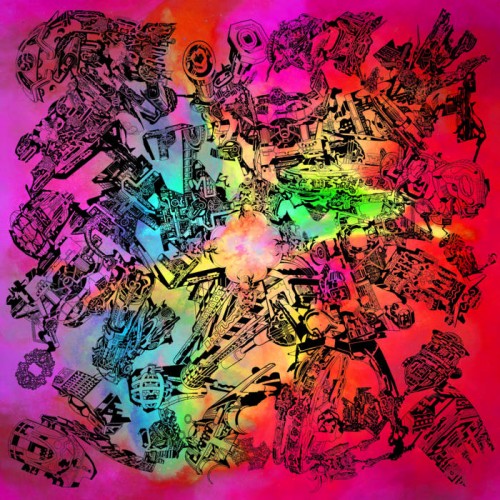Ad Hoc
 Every now and then you come across a product born of such radically alternative starting assumptions that it gets treated with near indifference by its potential audience, as though to even entertain the possibility of its existence could cause the tapestries of multiple musicotheologies to unravel. Infinity by K-Space is one such product: a CD that never plays the same music twice, intertwining ideas from disciplines such as improvisation, indeterminate composition, generative music and new media with anthropology, magic and non-musical sonic expression. While informed readers could be forgiven for commenting that it came out two years ago, at the time of writing no one seems to have been able to do justice to this remarkable record. That’s a shame, because it raises important questions about received wisdom in many of the key strata within experimental music, as well as offering potential solutions to peculiarly modern problems and avenues for future experimentation. So consider this a digested listen and a chance to reposition Infinity as one of the key musical documents of the last decade.
Every now and then you come across a product born of such radically alternative starting assumptions that it gets treated with near indifference by its potential audience, as though to even entertain the possibility of its existence could cause the tapestries of multiple musicotheologies to unravel. Infinity by K-Space is one such product: a CD that never plays the same music twice, intertwining ideas from disciplines such as improvisation, indeterminate composition, generative music and new media with anthropology, magic and non-musical sonic expression. While informed readers could be forgiven for commenting that it came out two years ago, at the time of writing no one seems to have been able to do justice to this remarkable record. That’s a shame, because it raises important questions about received wisdom in many of the key strata within experimental music, as well as offering potential solutions to peculiarly modern problems and avenues for future experimentation. So consider this a digested listen and a chance to reposition Infinity as one of the key musical documents of the last decade.
Far from a mere novelty album, Infinity is a product of over a decade’s careful enquiry and cannot be understood without some knowledge of its creators. K-Space is a trio featuring the UK’s Ken Hyder (Talisker, Bardo State Orchestra, Siberia Extreme) and Tim Hodgkinson (Henry Cow, The Work, Konk Pack) and the Tuvan shaman Gendos Chamzyryn (Biosintes). Hyder is widely admired for his carefully robust integration of jazz, improvisation and Scottish folk music; while Hodgkinson’s background was in social anthropology before his involvement in avant-rock, post punk and his work as a composer and improviser. The band formed in 1996 when the two of them travelled to Siberia to collaborate with local musicians – with a particular view to locating those with experimental predispositions – as part of their Radical Transcultural Initiatives project. Chamzyryn’s band Biosintes immediately impressed them, described by Hyder as being “like a Tuvan Sun Ra… costumes and everything, with bits of Marc Bolan and James Brown thrown in.” The name K-Space is derived from the work of Russian fringe scientist Nikolai Aleksandrovich Kozyrev, whose work into space/time distortion (particularly a spiraling mirror chamber known to produce peculiar physiological effects, including weightlessness, disorientation and nausea) has had a profound effect on the group.
All three are multi-instrumental, with each contributing vocals (Chamzyryn is an exponent of the Kargiraa tradition of overtone singing), percussion and dungur (a shamanic frame drum listed separately because of its predominantly ritual – as opposed to purely musical – associations) as the bedrock of their sound. Hyder is also credited as using ektara (single stringed banjo), Chamzyryn with cello, dopshuhluur, khomous (being Tuvan versions of lute and jew’s harps respectively) and chadagan (plucked zither), while Hodgkinson adds lap steel guitar and an assortment of wind and reed instruments. They practice a meaty and deeply satisfying collision of collective improvisation and shamanic ritual, piecing together their releases from field recordings that sweat with gritty hard-earned authenticity.
Each member is stubbornly committed to exploring new territory together as equals rather than appropriating each other’s musical or magical practices. In Hodgkinson’s own words:
The Western world is relentlessly imposing itself on all the other human worlds on this planet. As individuals, we can’t alter this process. But we can modulate what this world of ours is, we can ensure that the friction between worlds which should take place really does take place and that the other worlds are not simply crushed in silence… The point is that the friction should be real, that the touching surfaces should not be dissociated from their roots in social life, and that the impact between different musical cultures should therefore be thoroughly worked through. Only in this way can we avoid the kind of impressionistic World Music now being produced by some of our more careless contemporaries.
K-Space is a product of these principles, exploring the rich tension between sound making employed with a magical mindset in functional ritual contexts versus sound making used with a musical mindset in performed improvisation.
Shamans cannot be understood without magic (defined here as the sphere of human capability that intersects with the acausal and/or ineffable) and their societal context. It is a vocation: they are spirit mediators for their community, providing services that include healing, divination and intercession. Using the word ‘shaman’ to describe someone who wears costumes, uses repetitive rhythms and appears to be in an altered state is a bit like calling the Bow Gamelan Ensemble plumbers because they wear overalls, get their hands dirty and bang on pipes. Phenomena that are carelessly misinterpreted as ‘music’ are actually the secondary gain of a primarily magical engagement with sound and instrumentation, in which drumming, dance and vocalisations power the shamanic trance, monitor/reflect its progress and provide external reference points to onlookers. In this respect K-Space’ efforts are an essential corrective in the face of the shaman’s peculiarly fashionable misappropriation, whether it’s the sanitising or rebranding perpetrated by Michael Harner or careless music journalists stumblebumming their way with lazy descriptors.
By anyone else’ standards the aforementioned activities would already be over-achievement on a scale that could support whole idioms, let alone the work of three individuals. Before 2008’s Infinity K-Space had already produced two superb albums, 2002’s Bear Bones and 2004’s Going Up, both of which played with conventional notions of space and time by layering composites of recordings taken from markedly different acoustic environments (campfire field recordings, shamanic rituals, live performances and studio takes). But Infinity is something different again, and it represents such a shift in strategies that it’s impossible to assess using the standards accorded to most recorded media, having more in common with generative music and indeterminate composition.
Collaborator (also Freq contributor and Faust-pages webmaster) Andy Wilson coded K-Space’ field recordings into software that generates the music afresh with each new play using algorithms based on some of their implicit improvisation strategies. It’s neither random nor merely remixes itself: from the album’s Wikipedia article :
The audio files are categorized into a number of groups, including acoustic, live, solo, environmental and loops. A single audio file can be used in many different ways by varying, for example, dynamic levels, volume and duration of play. For a particular piece, for example, the software might select any two of seven acoustic files and play them together for X seconds, adding one of four environmental files after Y seconds… Each time “PLAY” is pressed, the software selects a new score which it uses to construct a new piece of music. The score consists of a set of audio file selection criteria, which vary depending on what has happened before. While there are a finite number of scores on the CD, there are many different interpretations of each score.
Simply put, Infinity is never the same album twice. And while many articles and reviews have focused on the mechanics of the project none have really considered its implications or how it fits into the singular narrative that Hyder, Hodgkinson and Chamzyryn are weaving together.
Infinity is first and foremost an elegant metaphor for the elusive psycho-spiritual reality in which shamans conduct a good deal of their work. Upon attaining an ecstatic state the shaman enters the spirit realm in which they are able to entreat, communicate, and bargain with the entities whose services they require. They perform their magic in dream worlds, made of overlapping histories and geographies, malleable symbols and illusory architecture. Anything and everything can exhibit multiple faces, and so negotiating these twilight zones and relating to their denizens is far removed from any kind of exact science. Many scholars of comparative religion believe that all human religion originates in such otherworlds. Infinity twists time and space back onto themselves, a hundred haunted houses built on shifting sands, a superimposition of locations separated by thousands of miles and an interlocking of events separated by years, a never-ending collision of new gestalts… in other words, a perfect mirror for the shaman’s innumerable alternate realities, fever dreamtimes and liminal landscapes. The band’s interest in Kozyrev’s idiosyncratic experiments can also be seen in this light: as an attempt to explore the shamanic experience from multiple angles, whether magical, anthropological, musical or scientific.
Hyder and Hodgkinson’s interest in shamanism began with an urge to explore the influence that a musician’s psychological state might have on the quality of their improvisation, specifically whether it might be of more importance than their assimilation of influences and technique. K-Space’ music – while being masterfully evocative (i.e.: successful at changing the psychological state of the listener) – refuses to indulge in puerile speed and eclecticism for sake of it. Furthermore, the technology behind Infinity raises questions regarding the value of commonly held assumptions in improvisation. Every time the listener presses play a fresh composition is generated, and each time the results sound congruent and of a piece, despite being recorded in contexts that may never have been intended for such radically fluid juxtapositions. It’s a hint that ‘interplay’ (a favourite term amongst music critics that rivals ‘shamanic’ as an unexamined descriptor) could be a myth projected by the listener. While there are clearly examples of improvisers who respond to each other with lightning speed and sensitivity, Infinity suggests that it could be just as common – if not more – for improvisers to set up their core sonic ingredients in such a manner that timbres and rhythms will always complement each other… or put another way, in a manner that cannot fail to be complementary. The notion of ‘risk’ is a key facet of many musicians’ arguably egotistical rationale in favour of improvisation. Here it seems as though the risks that K-Space are taking might be highlighting the lack of risk inherent in the music of many of their contemporaries.
Infinity occupies the fertile and unexplored junction between generative music, improvisation and indeterminate composition. It brings the close listening experience of live improvised music into the home, as musical events cannot be repeated or rewound when attention lapses. The sound files used in the music’s assembly are all recordings of live performances, and it feels slightly eerie to hear music generated from algorithmic rules that’s so sonically dissimilar to the kind of electronica more typically associated with Eno or Autechre. The album’s compositional logic – its generative seed – is based on K-Space’ analysis of their own developing musical strategies over a ten year timeframe. But what are those seeds, and how representative are the results? Infinity could be seen as indeterminate music with an absent score, leaving the listener wondering why its creators have not provided more details on the parameters within which each play is generated. Furthermore Andy Wilson’s software, slated for release in October 2008, has yet to be made public. Such omissions make this a slippery proposition, especially puzzling given the otherwise excellent supporting material included on the disc. Are K-Space protective of their process, concerned about perpetuating the kind of aggressive appropriation that they have otherwise studiously avoided? Or did they assume disinterest in the music’s compositional logic?
Every experience of art is relational and built over time. But what if the art is ephemeral and time keeps playing tricks on you? Where do you locate the relationship? In the moment, every time play is pressed? In the concept, the notion of an album that is never the same twice? In the execution, in trying to ascertain the invisible skeleton that unifies each play? Such music is as articulate an expression of the absent author, or of loss, transience and memory as any number of William Basinski compositions or hauntological disinterring. At every turn K-Space force you to question your assumptions regarding what you’re hearing. Is it improvisation when it is also the product of a computer simulating improvisational strategies? Is it generative music when so many of the ingredients are pre-recorded? Is it even music? Or is it the by-product of a magical ritual, the drum-as-horse/biofeedback that powers and monitors the shamanic trance, and only sounds like music due to its audience’ inexperience with some of the alternative uses of sound?
Finally, Infinity addresses many of the fundamental problems that exist because of the primacy that we place on conventional recording media. It’s probably no coincidence that Cage, Feldman, Cardew et al explored indeterminate methodologies at a time when recording was in its relative infancy. Their strategy of rejecting definitive versions is strikingly at odds with what has become a deluge of fixed, static sound objects on tape and vinyl. We’re now at the tail end of a century of recorded music with unparalleled access to endless archives of sound online. Record companies lobby for legislation that seeks to turn back time, desperate for us to buy into their victim narrative, oblivious to the fact that their disposable product is being treated in precisely the manner it deserves in an oversaturated market. Meanwhile smaller companies and DIY musicians fetishise tape and vinyl as objects to covet that are conveniently harder to rip, upload and distribute online. In these nostalgic, backward looking times, releasing a conventional album is just another drop in the ocean.
Amongst the first questions musicians should be asking themselves is “What makes me different? What is my unique contribution? What sets me apart?” These questions rarely, if ever, extend to format. It’s the elephant in the room that musicians refuse to acknowledge, hinting at a near total institutionalisation in favour of static recordings. Computers are now relatively cheap and easy and to programme, are increasingly the home listening platform of choice and frequently include speakers and microphones as standard. There are infinite options for experimenting with generation, indeterminacy and feedback. These days conventional recording methods and release strategies represent a tiny fraction of the platforms available, and it would be a tragedy for newer, under-explored options to be relegated to video game sideshows by a disinterested generation. Thousands of musicians acquire their unique voice through building their own instruments. Why aren’t there thousands building new media?
The sad reality is that every culture, every idiom, every working methodology, every acoustic environment, all the infinite possibilities of sound have become reduced in scope and scale, truncated, domesticated, archived and parcelled out, in stereo and lasting under eighty minutes. To paraphrase Tim Hodgkinson, whole worlds of possibility are being crushed in silence. K-Space, in their investigation of the magicoreligious methodology of our ancestors, have shown us invaluable inroads into our future. We would be wise to listen.
-Seth Cooke-



